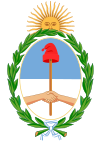INAPL
| Instituto Nacional De Antropología y Pensamiento Latinoamericano | |
 | |
| Agency overview | |
|---|---|
| Formed | 1943 |
| Headquarters | 3 de Febrero 1378, C1426BJN, C1426BJN CABA, Buenos Aires, Argentina |
| Parent department | Ministry of Culture (Argentina) |
| Website | inapl |
The National Institute of Anthropology and Latin American Thought[1] (Spanish: Instituto Nacional De Antropología y Pensamiento Latinoamericano; INAPL) is an Argentine government agency dedicated to preserving national cultural and archeological heritage. It is a part of Argentina's ministry of culture.[2]
History[]
The INAPL was created on December 20, 1943. It was created at the behest of Juan Alfonso Carrizo, who would become the institute's first director.[3]
The institute has had several names over the course of its existence; the first of these was The National Institute of Tradition assigned at its founding in 1943.[4] In the words of Briones and Guber, the institute was later renamed for political reasons to "the National Institute of Philology and Folklore in 1955, the National Institute of Folkloric Research in 1960, the National Institute of Anthropology in 1964, and [finally] the National Institute of Anthropology and Latin American Thought in 1992."[4]
Mission and function[]
The primary focus of the institute is the documentation, preservation, and recovery of cultural heritage, be it physical or non-physical. The institute carries out research in the areas of archaeology, anthropology, and folklore. In keeping with their mission, they also give recommendations and alternative proposals on regional economic and socio-cultural development.[3]
One of the programs of the INAPL is to preserve rock art sites and save them from deterioration and destruction. This program has been in place since 1995. Of these sites, Cueva de las Manos has been given top priority.[1]
Current and former projects[]
Among the institute's current and former projects is the study of the HMS Swift (1763), a British ship that sank off of the coast of Puerto Deseado in 1770.[5] The discovery and investigation of the ship was one of the first taken on by the INAPL's newly created underwater archaeology program in Argentina, which was formed in 1995.[5][6]
The INAPL, along with the National Scientific and Technical Research Council (CONICET), is also a major sponsor of the DocAnt film festival, the oldest currently-running anthropological film festival in Latin America.[7] The INAPL runs the National Museum of Man in Argentina.[8]
Notable members[]
- Sandra Analía Guillermo—recipient of the John L. Cotter Award in Historical Archaeology[9]
See also[]
- The National Scientific and Technical Research Council (CONICET)—an Argentine organization that works closely with the INAPL
References[]
- ^ Jump up to: a b Onetto, Maria (2014). "Cueva de las Manos, Río Pinturas Cave Art". In Smith, Claire (ed.). Encyclopedia of Global Archaeology. 3. New York, NY: Springer. pp. 1841–1843. doi:10.1007/978-1-4419-0465-2_1624. ISBN 978-1-4419-0426-3. LCCN 2013953915.
- ^ "Instituto Nacional de Antropología y Pensamiento Latinoamericano | Ministerio de Cultura". www.cultura.gob.ar (in Spanish). Retrieved 2021-06-19.
- ^ Jump up to: a b "Instituto Nacional de Antropología y Pensamiento Latinoamericano". Instituto Nacional de Antropología y Pensamiento Latinoamericano (in Spanish). Retrieved 2021-06-19.
- ^ Jump up to: a b Briones, Claudia; Guber, Rosana (2008). "Argentina: Contagious Marginalities". In Poole, Deborah (ed.). A Companion to Latin American Anthropology. Malden, MA: Blackwell Publishing. p. 19. doi:10.1002/9781444301328.ch1. ISBN 978-0-631-23468-5. OCLC 165081955.
- ^ Jump up to: a b Elkin, Dolores (2016-06-03) [First published in print in 2008 by Left Coast Press]. "Maritime Archaeology in Argentina at the Instituto Nacional de Antropología". In Leshikar-Denton, Margaret E; Luna Erreguerena, Pilar (eds.). Underwater and Maritime Archaeology in Latin America and the Caribbean. One world archaeology series (1 ed.). New York: Routledge. doi:10.4324/9781315416090. ISBN 978-1-315-41608-3 – via Google Books.
- ^ Erreguerena, Pilar Luna (December 2010). "Mexico: A Leader in Ratification of the UNESCO Convention on the Protection of the Underwater Cultural Heritage". Journal of Maritime Archaeology. 5 (2): 150. Bibcode:2010JMarA...5..143E. doi:10.1007/s11457-010-9069-7. ISSN 1557-2285. JSTOR 23753384. S2CID 162566211.
- ^ Peirano, Maria Paz (2017). Vallejo, Aida; Peirano, Maria Paz (eds.). Film Festivals and Anthropology. Cambridge Scholars Publishing. p. 78. ISBN 978-1-4438-1683-0. OCLC 974947575.
- ^ Japkin, Silvia (2010). "Tying together the chaguar threads". Datatèxtil (23): 23. ISSN 1139-028X.
- ^ Rolandi, Diana; Majewski, Teresita (June 2015). "Sandra Analía Guillermo". Historical Archaeology (published 24 October 2016). 49 (2): 15–17. doi:10.1007/BF03377137. ISSN 0440-9213. S2CID 164268591.
External links[]
| Wikimedia Commons has media related to INAPL. |
- Scientific organisations based in Argentina
- Government agencies of Argentina
- Research councils
- Argentina university stubs
